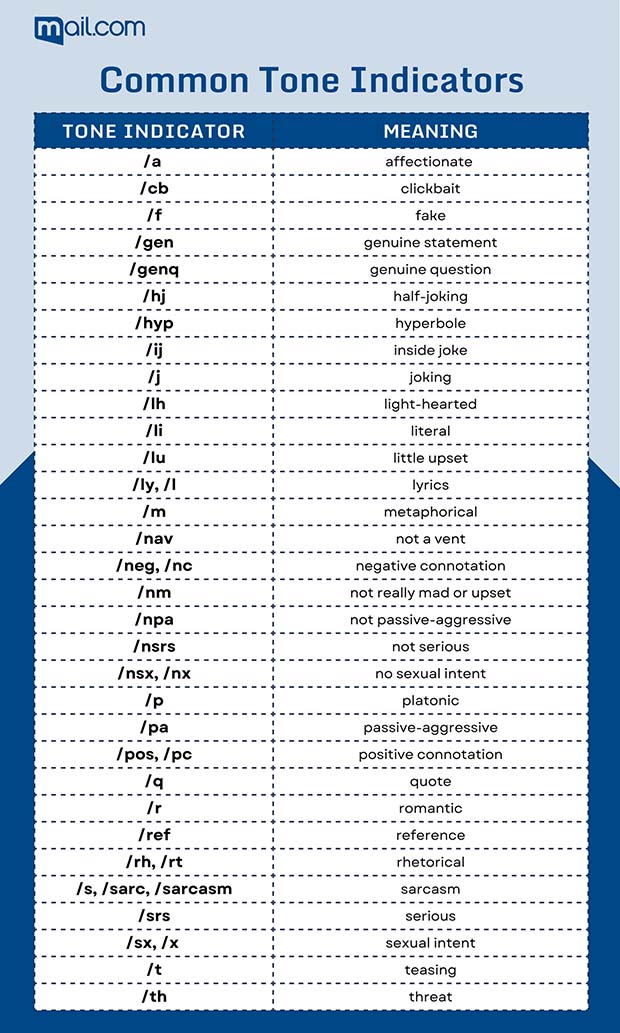Feeling misunderstood? Text tone indicators help clarify meaning online
If you are a frequent user of social media platforms, you may have spotted additions to people’s posts in the form of a slash and a letter, like this: /srs. This is called a tone indicator. Like the tone of a person’s voice pitched higher to indicate a question or louder to indicate anger, these markers help clarify the meaning of the words.

Why use tone indicators?
Clarity can be hard to achieve in written communications, where we don’t have facial expressions, body language, etc. to help us understand exactly what the other person means. So typing /j at the end of a statement lets the reader know you’re joking, while /g tells them your remark is genuine. In this sense a tone indicator is like an emoticon or emoji, but with even less room for interpretation.Who uses tone indicators – and where
Today you’ll find tone indicators being used on all sorts of online social media platforms, especially where posts are public and can be read, forwarded and reposted by people who don’t necessarily know the original poster and so might not understand their intent. Think of a simple remark like “That's just what I needed today!” Is the writer happy or frustrated? In a forum like Twitter where words are often seen or taken out of context, it can be impossible to know. Tone indicator enthusiasts say that adding them removes any possibility of misinterpretation.Tone indicators have also gained popularity among some people with neurological differences, like autism spectrum disorder, who say they sometimes miss cues that someone may be flirting or being sarcastic – so it helps to have the meaning spelled out. With this in mind, some people have started using tone indicators because they believe it is inclusive and helps others have a better online experience.
The age-old challenge of communicating in writing
Many people credit online forums like Reddit for giving rise to this trend, specifically the use of “/s” as a sarcasm tone indicator. This and other tone indicators also started popping up on Twitter in 2020. But people have been grappling with the problem of conveying tone in written communications for at least 500 years now. One often-cited early example from 1575 is Henry Denham, a British printer who tried to show that a question was rhetorical by punctuating it with a backward question mark. One hundred years after Denham, another frustrated writer suggested using upside-down exclamation marks to indicate irony.None of these ideas really gained traction until the rise of computer-based communications in the 1980s. This was the decade that gave rise to the first emoticons, like the sideways smiley :-) that serves as a joke marker. And other internet abbreviations like “LOL” also date from this era.
Tone indicators vs. emojis
So why do some people favor tone indicators over the more widespread emojis? Now that there is such a wide range of emojis out there and different people using them differently, sometimes they can cause more confusion than clarity – especially between age groups and cultures. Does anyone really know the shades of meaning expressed by the 15+ smiling emojis available on their phone? It’s much clearer to type /j to show you’re joking.32 useful tone indicators
Although you’ll find lists of tone indicators that contain more or different examples, this set, which is organized alphabetically, should be enough to get you started:- /a: affectionate
- /cb: clickbait*
- /f: fake
- /gen: genuine statement
- /genq: genuine question
- /hj: half-joking
- /hyp: hyperbole
- /ij: inside joke
- /j: joking
- /lh: light-hearted**
- /li: literal
- /lu: little upset
- /ly, /l: lyrics (used to show you’re quoting a song)
- /m: metaphorical
- /nav: not a vent
- /neg, /nc: negative connotation***
- /nm: not really mad or upset
- /npa: not passive-aggressive
- /nsrs: not serious
- /nsx, /nx: no sexual intent
- /p: platonic
- /pa: passive-aggressive
- /pos, /pc: positive connotation****
- /q: quote
- /r: romantic
- /ref: reference
- /rh, /rt: rhetorical
- /s, /sarc, /sarcasm: sarcasm*****
- /srs: serious
- /sx, /x: sexual intent
- /t: teasing
- /th: threat
**The /lh tone indicator sometimes causes confusion. It means that something that might be interpreted as criticism or meanness is meant in a kind or loving way, e.g. “Maybe you should start setting an alarm /lh”.
*** The /neg tone indicator is used for statements, especially emotionally charged statements, that carry a negative or downbeat tone to avoid being mistaken as sarcastic or insincere. /neg does not imply an insult, but it can indicate sincere criticism.
**** In contrast to the /neg tone indicator, the /pos tone indicator signifies that even if a statement comes off as intense or emotional, it’s meant in a positive or happy way.
*****The /s tone indicator is especially important because distinguishing sarcasm in written communication can be difficult. We recommend using the tone indicator with people who might not know you very well and would not be able to tell when you are being sarcastic over text.
Bonus explainer: Tone indicators are commonly used in text messages, but what about the abbreviations you often see in emails? Check out our deep dive: FYI? EOD? Email abbreviations & their meanings
Tone indicator list
Here’s the list of tone indicators in a handy format you can save for future reference!
Was this article interesting? Before you get busy adding tone indicators to your tweets, leave us some feedback below. /srs
This article first appeared on Aug. 29, 2022, and was updated on October 30, 2024.
Images: 1&1/Shutterstock
175 people found this article helpful.
Related articles